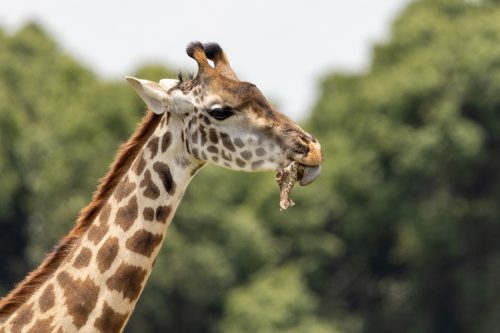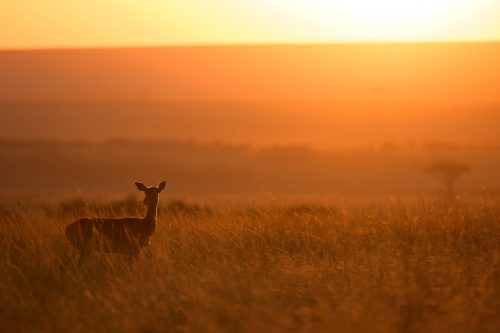The Migration is still with us here and delivering fantastic sightings for our guests around the Triangle. With the recent spate of rain, there’s now fresh grass sprouting in the areas where these herds have already mowed the grassland down.
This year, the herds' movements have been an exciting first for me as they are crossing the Mara River from the Triangle back towards the Greater Mara. Typically, the herds first cross towards the Triangle and then only into the Serengeti. The reason for this change in behaviour is likely from the bellowing smoke seen coming from the Greater Mara around a month ago — the sign of controlled burning in preparation for the coming rains. Without any specific leaders, the groups of wildebeest and zebra make their way toward the River as the lure of the fresh grass is impossible to ignore. Eventually, the herds will cross the Mara River again towards the Triangle, before going back to the Serengeti.
The high water level has turned the Mara River into a deadly cauldron for the herds who are constantly searching for greener pastures. They face danger in the form of trampling due to the sheer numbers around them, drowning at the jaws of crocodiles that lie in wait or being caught by other predators lurking on the banks. Ballooning carcasses can be spotted along the river, which will nourish an entire ecosystem of river fish, microorganisms and birds.
As the season of plenty continues, predators are still making the most of it as we caught up with the Swamp lioness with her sub-adult males. These cats had gorged themselves heavily, as evidenced by their bulging stomachs, looking quite uncomfortable while resting under the shade of a tree. As I counted, I wondered where the third male was when suddenly there was a commotion behind us and he appeared carrying a last piece from their kill.
With no intention of eating the piece, not one lion bothered to fight for it — except a very brave monitor lizard who appeared on the scene surprisingly unintimidated by the bigger cats. This one boldly gnawed its way through the bones right in front of some very dangerous spectators. These lizards pack a powerful punch from their muscular tails, which is their primary line of defence.
The BBC male leopard, also known as Osidai, has been making the most of these migrating herds as well, moving around in the company of a female called Nakwet, since last month. This week, we spotted them walking along the creek at the BBC Area as a big group of wildebeest were making their way to cross the creek — and we knew we were set for a possible kill.
The unsuspecting wildebeest didn't see the leopard waiting inside the ravine picking its moment to attack, while the very shy Nakwet scampered to safety. As we waited and wondered when the lurking male would attack, the wildebeest kept streaming across until they were suddenly cut off — the attack was so swift that all we could see was the leopard locked tightly on the neck of a young wildebeest. Its death was swift as the BBC male dragged his prize to feed in the shade away from prying eyes.
Onto lighter and faster predators, Ruka and Rafiki also look as if they have had a few successful hunts as of late. We caught up with the two brothers with full bellies making their way to the shade to digest their food.
Martial eagles are apex predators and sit perched atop the avian food chain in their environment. These giant birds are equipped to hunt a wide variety of prey from medium-sized mammals down to birds and reptiles. Guide Lemaalo and his guests came across an unusual sighting as they spotted an eagle sitting in the water.
Moments later, the eagle lifted its huge wings — spanning over six feet — to reveal a heron it had been trying to drown. The die-hard heron was still alive but there was no chance of escaping the clutch of the eagle's strong talons as it dragged its catch away from the pond.
We are very pleased to rectify an error on our blog from two weeks ago when we said that our beloved Angama lioness had two new cubs — we now have clear photo evidence that there are, in fact, three cubs. The little ones were spotted following their mother in the company of the male who had, unfortunately, killed her previous litter, but may indicate he is the father and will offer them protection.
However, on another day, we found the Angama lioness in the company of a different young male from the Owino Pride, who had formed a coalition with the Lamai male. There was some baffling behaviour happening as we noticed that the Owina male was intent on mating with her. He was so fixated that he even ignored her clearly agitated attempts to hunt zebra. It's strange for the young male to try and mate with a lioness who has recently given birth while the cubs are still alive and the father is still around. Once again, we are left hoping for the cubs' survival if this behaviour persists.

A year ago, Lemaalo taught us an interesting lesson on osteophagy, a behaviour where animals, mainly herbivores, chew bones to supplement their diet with calcium and phosphorous, which their bodies need.
Filed under: This Week at Angama
Subscribe for Weekly Stories
Comments (0):

Rates & Availability